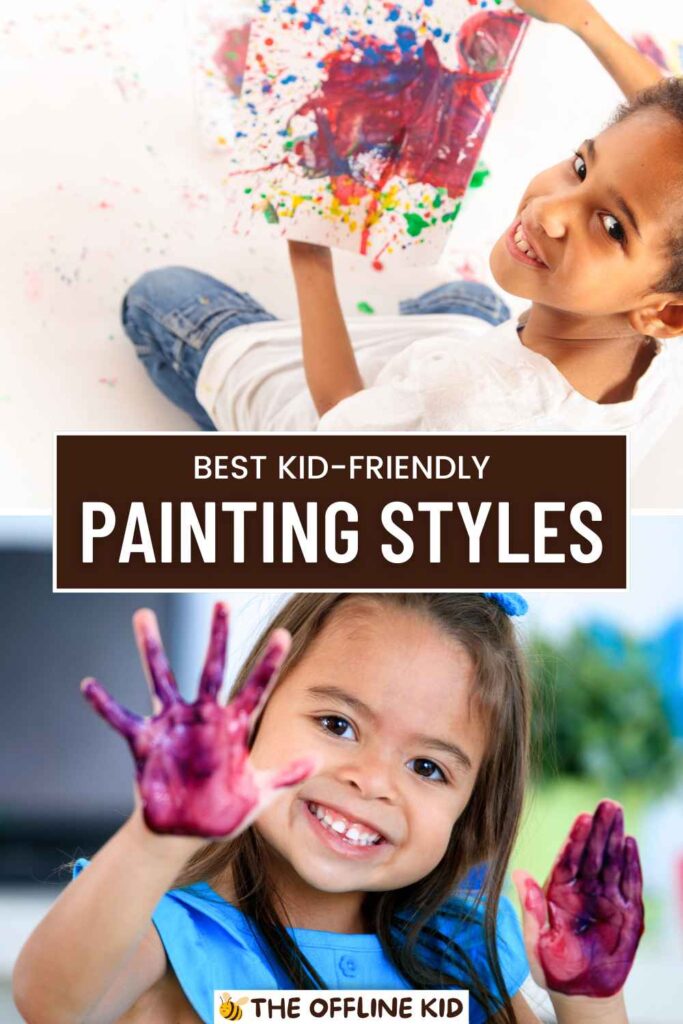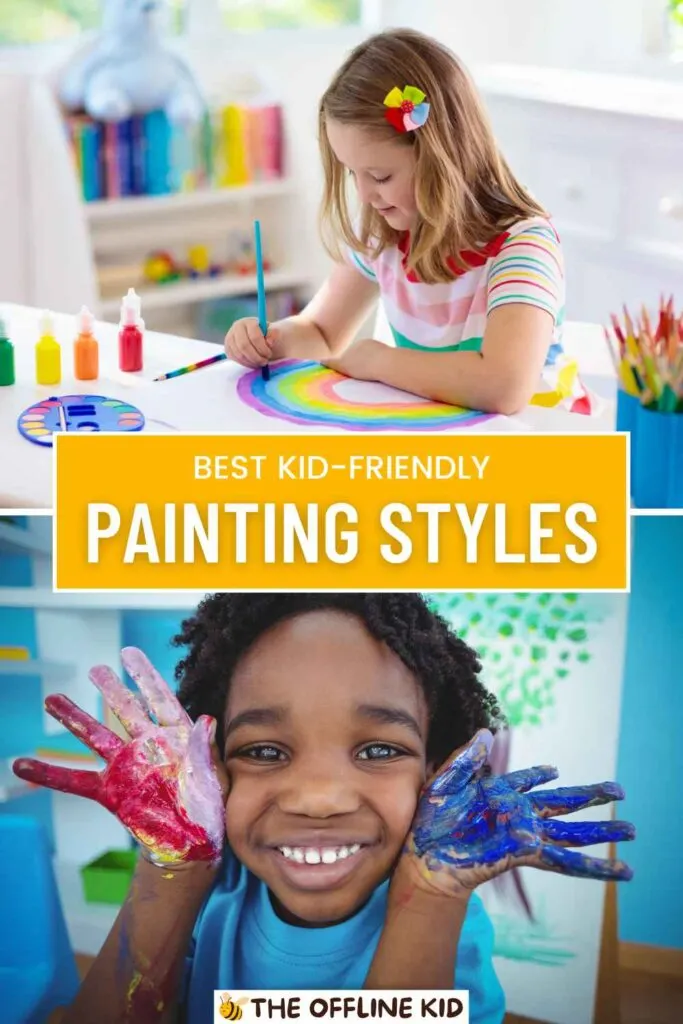Encouraging children to paint fosters creativity, boosts motor skills, and enhances emotional well-being.
Discover the best painting styles, techniques, and fun projects tailored for kids of all ages in this comprehensive guide.
Why Painting is Great for Kids
Enhancing Fine Motor Skills
Painting helps children develop their fine motor skills as they learn to hold brushes, mix colors, and create shapes.
This skill is crucial for tasks like writing and using tools.
Key Benefits:
- Improved hand-eye coordination
- Strengthened hand muscles
- Better control over small movements
Boosting Creativity and Imagination
Painting encourages kids to think outside the box and use their imagination.
They can create anything they envision, leading to a sense of accomplishment and pride.
Creative Advantages:
- Freedom of expression
- Exploration of new ideas and concepts
- Development of problem-solving skills
Encouraging Self-Expression
Through painting, children can express their emotions and thoughts without words. This form of self-expression is particularly beneficial for kids who may struggle to communicate verbally.
Expression Benefits:
- Emotional release
- Increased self-awareness
- Improved mood and mental health
Improving Emotional Well-Being
Engaging in creative activities like painting has been shown to reduce stress and anxiety in children. It provides a fun and relaxing outlet for them to unwind and enjoy themselves.
Emotional Advantages:
- Reduced stress levels
- Enhanced sense of calm
- Boosted overall happiness
Building Confidence and Self-Esteem
Completing a painting project gives children a sense of achievement, which can boost their confidence and self-esteem.
Positive reinforcement from parents and educators further encourages them to continue exploring their artistic talents.
Confidence Boosters:
- Sense of pride in their work
- Encouragement to take on new challenges
- Recognition of their unique abilities
Encouraging Patience and Perseverance
Painting teaches children the value of patience and perseverance. They learn that creating something beautiful often takes time and effort, helping them develop a resilient mindset.
Character Building:
- Understanding the importance of practice
- Learning to overcome challenges
- Developing a growth mindset
By understanding these benefits, parents and educators can better appreciate the positive impact that painting can have on a child’s development.
Encouraging kids to explore different painting styles will not only nurture their artistic abilities but also contribute to their overall growth and well-being.
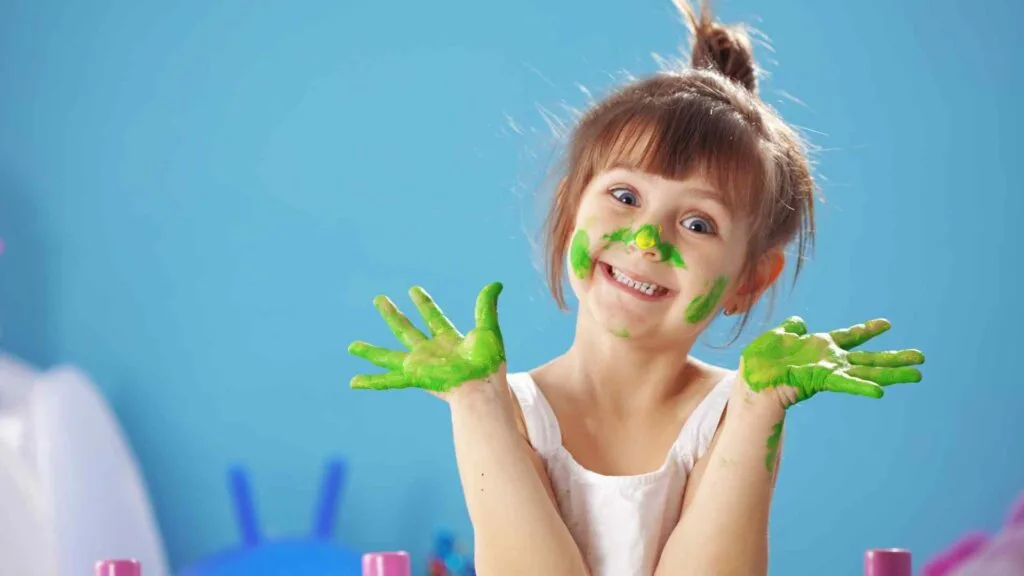
Understanding Different Painting Styles
Brief Introduction to Various Painting Styles
Painting offers a myriad of styles, each with its unique techniques and appeal.
Understanding these styles can help in selecting the most suitable ones for children to explore and enjoy.
Popular Painting Styles:
- Watercolor: Known for its translucent, soft washes and blending capabilities.
- Acrylic: Versatile and vibrant, perfect for bold, colorful creations.
- Tempera: Non-toxic and bright, ideal for young children.
- Finger Painting: Sensory-rich and perfect for tactile exploration.
- Mixed Media: Combines various materials for a textural and creative experience.
- Digital Painting: Modern and tech-savvy, using digital tools for limitless possibilities.
Importance of Experimenting with Different Styles
Encouraging kids to try various painting styles fosters a more comprehensive artistic development. Each style offers unique challenges and rewards, helping children discover their preferences and strengths.
Benefits of Experimentation:
- Broadens artistic horizons
- Enhances adaptability and flexibility
- Develops a deeper appreciation for art
Factors to Consider When Choosing a Painting Style for Kids
Selecting the right painting style for a child involves considering several factors to ensure a positive and enriching experience.
Age and Skill Level:
- Toddlers: Simple, sensory-rich styles like finger painting.
- Preschoolers: Basic techniques with watercolor and tempera.
- School-aged children: More complex styles like acrylic and mixed media.
Materials and Safety:
- Non-toxic supplies: Always prioritize safety with young children.
- Ease of use: Choose materials that are easy to handle and clean up.
Interests and Preferences:
- Personal preferences: Encourage styles that align with the child’s interests.
- Thematic projects: Select styles based on project themes, such as nature scenes or abstract art.
Environment and Space:
- Setup and cleanup: Consider the practicality of setting up and cleaning the painting area.
- Indoor vs. outdoor: Some styles are better suited for outdoor activities to manage mess and space.
By understanding these painting styles and considering the relevant factors, parents and educators can provide a supportive and inspiring environment for children to explore their artistic potential.
This foundational knowledge sets the stage for delving into specific painting techniques and projects tailored for kids.
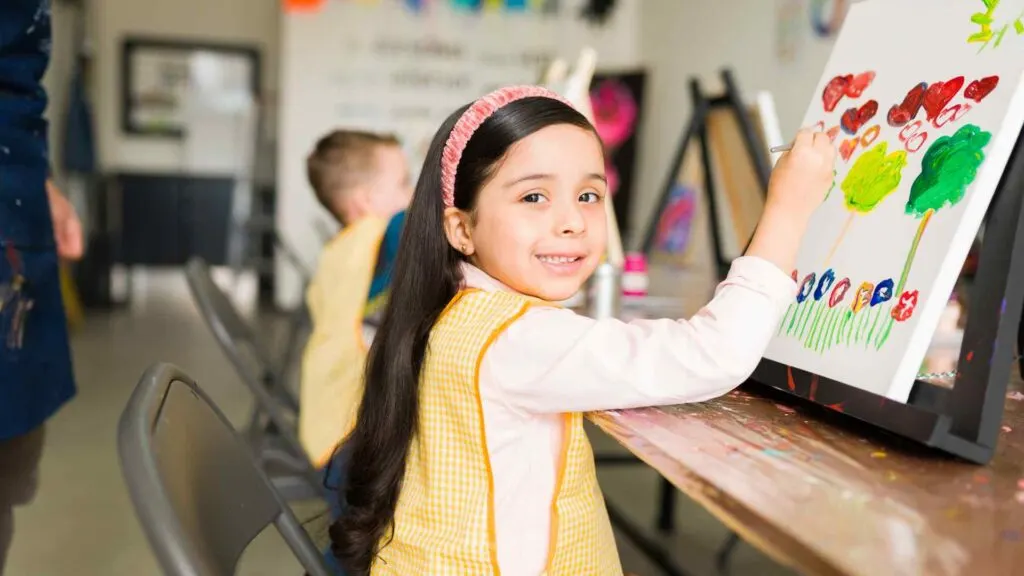
Watercolor Painting
Overview of Watercolor Painting
Watercolor painting involves using water-soluble pigments to create soft, translucent washes of color. This style is highly versatile and can produce both delicate and vibrant artworks.
Key Characteristics:
- Transparency: Allows light to pass through, creating a luminous effect.
- Blendability: Colors can easily blend, resulting in smooth gradients.
- Layering: Multiple layers can be applied to build depth and texture.
Benefits for Kids
Watercolor painting offers numerous advantages for young artists, making it an excellent choice for children of all ages.
Easy to Clean:
- Water-based paints are simple to wash off skin and surfaces.
- Minimal setup and cleanup time, allowing for more focus on painting.
Soft and Subtle Results:
- Produces gentle, visually appealing artworks.
- Encourages a light touch, helping to develop fine motor skills.
Techniques to Try
Introducing kids to different watercolor techniques can enhance their creativity and skill set.
Wet-on-Wet:
- Wetting the paper before applying paint.
- Creates soft, diffused edges and beautiful blends.
- Ideal for painting skies, water, and abstract designs.
Wet-on-Dry:
- Applying wet paint to dry paper.
- Produces sharper, more defined edges.
- Great for detailed work and layering colors.
Salt Texture:
- Sprinkling salt on wet paint to create interesting textures.
- As the paint dries, the salt absorbs moisture, leaving behind unique patterns.
- Perfect for adding texture to landscapes and abstract art.
Fun Projects
Engaging kids in enjoyable watercolor projects can make learning fun and memorable.
Nature Scenes:
- Encourage children to paint elements from nature, such as trees, flowers, and animals.
- Use wet-on-wet techniques to create soft backgrounds, adding details with wet-on-dry methods.
Abstract Shapes:
- Allow kids to experiment with colors and shapes without focusing on specific subjects.
- Use salt texture techniques to add an extra dimension to their artwork.
Tips for Success
Providing guidance and encouragement can help kids make the most of their watercolor painting experience.
Use Quality Supplies:
- Invest in good-quality watercolor paints and brushes to ensure better results.
- Use watercolor paper designed to handle the wetness of the paint.
Encourage Experimentation:
- Allow kids to try different techniques and color combinations.
- Emphasize the process of painting rather than the final product.
Be Patient:
- Watercolor painting can be unpredictable, so teach children to embrace the unexpected results.
- Encourage them to keep practicing and experimenting with new ideas.
Watercolor painting is a delightful and accessible way for kids to explore their creativity. With its blendable colors and versatile techniques, it provides a wonderful foundation for young artists to develop their skills and express themselves through art.
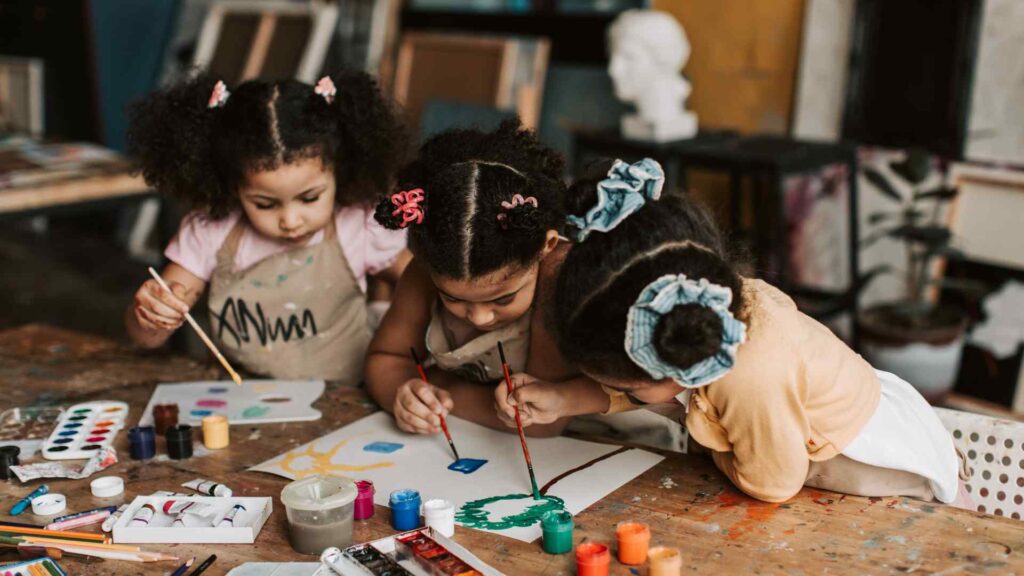
Finger Painting
Overview of Finger Painting
Finger painting is a tactile and sensory-rich activity where children use their fingers, hands, and sometimes other parts of their bodies to apply paint directly to the surface.
This style is perfect for young children as it allows them to explore and create without the need for brushes or other tools.
Key Characteristics:
- Direct Contact: Using fingers for a hands-on painting experience.
- Sensory Exploration: Engages multiple senses, enhancing the painting experience.
- Freedom of Expression: Encourages spontaneity and creativity.
Benefits for Kids
Finger painting offers numerous developmental benefits and is particularly suited for younger children.
Sensory Experience:
- Engages touch, sight, and sometimes smell, creating a rich sensory experience.
- Helps children understand different textures and sensations.
Enhances Tactile Awareness:
- Develops fine motor skills through direct manipulation of the paint.
- Improves hand-eye coordination as children create shapes and patterns.
Techniques to Try
Exploring various finger painting techniques can make the activity more enjoyable and educational.
Swirls and Dots:
- Create swirls, dots, and other simple patterns using fingertips.
- Encourage children to experiment with different pressure levels and finger movements.
Handprints and Footprints:
- Use hands and feet to make prints on paper.
- Combine different colors and positions to create interesting designs and patterns.
Fun Projects
Finger painting projects can be both fun and educational, fostering creativity and imagination.
Animal Prints:
- Create animal shapes using hand and finger prints.
- Use additional paint and fingers to add details like eyes, ears, and tails.
Underwater Scenes:
- Paint an underwater world with fish, seaweed, and bubbles.
- Use fingers to create fish shapes and swirling water patterns.
Tips for Success
Providing a supportive environment and appropriate materials can enhance the finger painting experience for kids.
Use Safe and Non-Toxic Paints:
- Ensure paints are safe for skin contact and easy to clean.
- Choose washable paints to minimize mess and make cleanup easier.
Create a Mess-Friendly Space:
- Set up a designated area with protective coverings to manage spills.
- Dress children in old clothes or aprons to keep them clean.
Encourage Free Expression:
- Let kids explore and create without too many restrictions.
- Focus on the joy of painting rather than the final outcome.
Provide Positive Reinforcement:
- Praise children for their efforts and creativity.
- Display their artwork to boost confidence and pride.
Finger painting is a joyful and beneficial activity that allows children to explore their creativity through direct interaction with paint.
By engaging in this tactile form of art, kids can develop their motor skills, enhance their sensory awareness, and enjoy the freedom of artistic expression.
Acrylic Painting
Overview of Acrylic Painting
Acrylic painting involves using fast-drying paints made of pigment suspended in acrylic polymer emulsion. Acrylics are known for their versatility and vibrant colors, making them a favorite among artists of all ages.
Key Characteristics:
- Vibrancy: Bright, bold colors that stand out.
- Versatility: Can be used on various surfaces like canvas, wood, and paper.
- Durability: Creates long-lasting artworks that resist fading.
Benefits for Kids
Acrylic painting offers several advantages for children, helping them explore different techniques and express their creativity.
Vibrant Colors:
- Allows kids to create bright and eye-catching artworks.
- Encourages experimentation with color mixing and blending.
Quick Drying:
- Reduces waiting time between layers.
- Minimizes the risk of smudging and accidental mixing.
Techniques to Try
Introducing children to various acrylic painting techniques can expand their artistic skills and creativity.
Layering:
- Apply multiple layers of paint to build up colors and textures.
- Start with background layers and add details on top as each layer dries.
Dry Brushing:
- Use a dry brush with a small amount of paint to create texture and highlights.
- Ideal for adding details like grass, fur, or textured surfaces.
Stippling:
- Create patterns and textures using small dots of paint.
- Use the tip of a brush or a sponge to apply the dots.
Fun Projects
Engaging kids in exciting acrylic painting projects can make learning enjoyable and rewarding.
Portraits:
- Encourage children to paint self-portraits or portraits of family members.
- Focus on capturing facial features and expressions.
Landscapes:
- Paint scenes from nature, such as mountains, forests, or beaches.
- Use layering techniques to create depth and dimension.
Tips for Success
Offering guidance and setting up a conducive painting environment can help children make the most of their acrylic painting experience.
Use Quality Supplies:
- Invest in good-quality acrylic paints and brushes.
- Use canvas or heavy paper that can handle the thickness of acrylic paint.
Protect Surfaces:
- Cover the painting area with newspaper or plastic to prevent spills.
- Encourage children to wear old clothes or aprons.
Encourage Creativity:
- Allow kids to experiment with different techniques and color combinations.
- Praise their efforts and celebrate their unique artistic styles.
Clean Brushes Properly:
- Teach children how to clean brushes thoroughly after use to prolong their lifespan.
- Use water and mild soap to remove acrylic paint from brushes.
Acrylic painting is a dynamic and engaging art form that offers children the opportunity to create vibrant, durable artworks. By exploring various techniques and projects, kids can develop their artistic skills and enjoy the process of creating unique and expressive paintings.

Tempera Painting
Overview of Tempera Painting
Tempera painting uses fast-drying paint made from pigments mixed with a water-soluble binder, typically egg yolk or a modern equivalent.
This type of paint has been used for centuries and is known for its bright colors and matte finish.
Key Characteristics:
- Bright and Opaque Colors: Produces vivid and solid colors that stand out.
- Fast-Drying: Dries quickly, allowing for layering and quick completion.
- Matte Finish: Results in a non-reflective surface that highlights colors.
Benefits for Kids
Tempera painting is particularly suitable for young children due to its safety and ease of use.
Safe and Non-Toxic:
- Most tempera paints are non-toxic, making them safe for kids to use.
- Ideal for use in classrooms and home settings.
Bright and Opaque Colors:
- Encourages bold and colorful artwork.
- Easy to mix and apply, providing satisfying results for beginners.
Techniques to Try
Exploring different tempera painting techniques can help children discover new ways to express their creativity.
Blending:
- Mix colors directly on the paper to create smooth transitions and gradients.
- Use a damp brush to blend edges and create a softer look.
Sgraffito:
- Apply a layer of tempera paint and let it dry.
- Paint another layer of a different color on top.
- Use a sharp tool (like the back of a brush) to scratch away parts of the top layer, revealing the color beneath and creating intricate designs.
Washes:
- Dilute tempera paint with water to create light washes.
- Apply these washes to create soft backgrounds or to build layers of color.
Fun Projects
Involving kids in tempera painting projects can make the learning process fun and interactive.
Seasonal Themes:
- Paint scenes or objects related to different seasons, such as autumn leaves, winter snowflakes, or spring flowers.
- Use blending techniques to create realistic seasonal effects.
Fantasy Scenes:
- Encourage kids to create their own fantasy worlds, complete with dragons, castles, and magical creatures.
- Use sgraffito to add details and texture to their fantastical creations.
Tips for Success
Providing a supportive and well-prepared environment can enhance the tempera painting experience for children.
Use Quality Supplies:
- Choose good-quality tempera paints and sturdy brushes.
- Provide thick paper or cardboard that can handle the weight of the paint.
Protect the Painting Area:
- Cover surfaces with newspaper or plastic to manage spills.
- Dress children in old clothes or aprons to prevent stains.
Encourage Experimentation:
- Let kids explore different techniques and color combinations without strict guidelines.
- Emphasize the importance of the creative process over the final product.
Provide Positive Feedback:
- Praise children for their efforts and creativity.
- Display their artworks to boost their confidence and pride in their work.
Tempera painting is an excellent way for children to explore their artistic abilities with bright colors and simple techniques. By engaging in various projects and techniques, kids can develop their skills, express their creativity, and enjoy the joy of creating art.
Mixed Media Painting
Overview of Mixed Media Painting
Mixed media painting involves combining various art materials and techniques in a single artwork. This style encourages creativity and experimentation, allowing kids to explore different textures, colors, and forms.
Key Characteristics:
- Combines Various Materials: Uses a mix of paints, papers, fabrics, and other materials.
- Textural Variety: Adds depth and interest through different textures.
- Creative Freedom: Encourages imaginative combinations and innovative approaches.
Benefits for Kids
Mixed media painting offers a unique and enriching experience for children, enhancing their artistic development.
Encourages Creativity:
- Allows kids to think outside the box and combine different elements in innovative ways.
- Fosters a sense of freedom and experimentation in their artwork.
Combines Different Textures:
- Introduces children to the concept of texture in art.
- Develops their tactile and visual awareness.
Techniques to Try
Introducing children to various mixed media techniques can broaden their artistic horizons and skill sets.
Collage with Painting:
- Combine painted backgrounds with cut-out shapes from magazines, colored papers, or fabric.
- Glue the cut-outs onto the painted surface and add details with paint.
Adding Found Objects:
- Incorporate natural or found objects like leaves, feathers, buttons, or beads into the artwork.
- Use glue to attach these objects, creating a three-dimensional effect.
Using Different Tools:
- Experiment with unconventional tools like sponges, toothbrushes, or stamps to apply paint.
- Create unique textures and patterns by using these tools in different ways.
Fun Projects
Mixed media projects can be engaging and educational, providing children with opportunities to explore and create.
Storytelling Art:
- Encourage kids to create a visual story using a mix of materials.
- Use collage elements to represent characters and scenes, adding painted details for context.
Personal Collages:
- Have children create collages that represent their interests, hobbies, or family.
- Combine photos, drawings, and found objects to create a personalized artwork.
Tips for Success
Providing a well-prepared environment and the right materials can enhance the mixed media painting experience for kids.
Gather a Variety of Materials:
- Collect different types of paints, papers, fabrics, and found objects.
- Ensure all materials are safe and suitable for children.
Set Up a Creative Space:
- Designate an area where kids can freely experiment with different materials.
- Cover surfaces to protect from spills and messes.
Encourage Exploration:
- Allow children to try new techniques and combine materials in unexpected ways.
- Emphasize the importance of the creative process over the final outcome.
Provide Guidance and Support:
- Offer suggestions and ideas while allowing kids to lead their creative projects.
- Celebrate their unique creations and encourage them to keep exploring.
Mixed media painting is a fantastic way for children to explore their creativity and develop new artistic skills. By combining different materials and techniques, kids can create unique and expressive artworks that reflect their individual style and imagination.
Digital Painting
Overview of Digital Painting
Digital painting involves using software and digital tools to create art on a computer or tablet. This modern approach to painting offers endless possibilities and is becoming increasingly popular among young artists.
Key Characteristics:
- Technology-Based: Utilizes digital devices and software.
- Limitless Possibilities: Offers a wide range of tools, colors, and effects.
- Undo Feature: Allows easy correction of mistakes.
Benefits for Kids
Digital painting provides numerous advantages for children, combining technology with creativity.
Modern Skills:
- Introduces kids to digital art, a valuable skill in today’s tech-driven world.
- Encourages familiarity with digital tools and software.
Endless Possibilities:
- Offers a vast array of colors, brushes, and effects that are not limited by physical supplies.
- Encourages experimentation and creativity without the fear of running out of materials.
Techniques to Try
Exploring different digital painting techniques can help children become proficient in this art form.
Basic Digital Tools:
- Familiarize kids with the basic tools available in digital painting software, such as brushes, erasers, and layers.
- Practice creating simple shapes and lines to get comfortable with the digital interface.
Layering and Blending:
- Use layers to separate different parts of the artwork, making it easier to edit and add details.
- Experiment with blending modes to create smooth transitions and effects.
Using Digital Brushes:
- Explore various digital brushes that mimic traditional painting tools like watercolors, oils, and pastels.
- Try different brush settings to achieve unique textures and styles.
Fun Projects
Engaging kids in digital painting projects can make learning this modern art form fun and exciting.
Digital Portraits:
- Encourage children to create digital self-portraits or portraits of friends and family.
- Use layers to separate the background, face, and details, making it easier to edit each part.
Fantasy Landscapes:
- Have kids design their own fantasy worlds with digital tools.
- Use a variety of brushes and effects to create detailed and imaginative landscapes.
Tips for Success
Providing the right tools and guidance can help children thrive in digital painting.
Choose User-Friendly Software:
- Select digital painting software that is suitable for kids, such as Procreate, Tux Paint, or Adobe Fresco.
- Look for programs with intuitive interfaces and a variety of tutorials.
Invest in a Drawing Tablet:
- A drawing tablet can enhance the digital painting experience by providing a more natural drawing feel.
- Choose a tablet that is compatible with your chosen software and appropriate for the child’s age and skill level.
Encourage Exploration:
- Allow kids to explore different tools and techniques within the software.
- Emphasize the fun of creating and experimenting rather than focusing solely on the final product.
Provide Positive Feedback:
- Praise children for their efforts and creativity in their digital artwork.
- Display their digital paintings just as you would with traditional artworks.
Digital painting offers a modern and versatile platform for children to express their creativity. By exploring various tools and techniques, kids can create vibrant and imaginative artworks while developing valuable digital skills.
Painting Styles for Different Ages
Toddlers (1-3 years)
Toddlers are naturally curious and love to explore different textures and colors. Painting activities for this age group should focus on sensory experiences and safety.
Simple and Safe Techniques:
- Finger Painting: Allows toddlers to use their hands to explore textures and colors. Use non-toxic, washable paints.
- Sponge Painting: Soft sponges dipped in paint create fun shapes and patterns.
- Dot Markers: Large, easy-to-hold markers that create dots without the mess of liquid paint.
Focus on Sensory Experiences:
- Textures: Incorporate different textures like sand or rice in paint.
- Colors: Use bright, primary colors to engage their interest.
- Shapes: Encourage creating simple shapes like circles and squares.
Preschoolers (4-5 years)
Preschoolers are developing fine motor skills and beginning to understand more complex concepts. Painting activities can become more structured while still allowing for plenty of creativity.
Introduction to Basic Techniques:
- Watercolor Washes: Simple techniques like wet-on-wet or wet-on-dry to create backgrounds.
- Stamping: Using objects like potatoes or leaves dipped in paint to create prints.
- Basic Brushwork: Teaching how to hold and use a brush to create lines and shapes.
Encouraging Creativity:
- Themed Projects: Paint themes like animals, nature, or favorite stories.
- Color Mixing: Simple exercises in mixing primary colors to create secondary colors.
- Guided Art: Follow-along activities where kids add their personal touches to a structured project.
School-Aged Children (6-12 years)
School-aged children can handle more complex painting techniques and projects. This age group benefits from exploring different styles and refining their skills.
More Complex Techniques:
- Acrylic Painting: Using acrylics for vibrant, durable artworks.
- Layering: Techniques like layering colors and adding details.
- Detail Work: Encouraging fine detail and precision in their paintings.
Experimenting with Different Styles:
- Mixed Media: Combining various materials like paint, paper, and found objects.
- Abstract Art: Exploring non-representational art and experimenting with form and color.
- Thematic Exploration: In-depth projects like painting a series on a particular theme (e.g., seasons, animals, fantasy worlds).
Tips for All Ages
Regardless of age, creating a supportive and encouraging environment can help children enjoy and benefit from painting.
Creating a Supportive Environment:
- Provide Appropriate Materials: Ensure paints, brushes, and surfaces are suitable for the child’s age and skill level.
- Designate a Painting Area: Set up a space where kids can paint freely without worrying about making a mess.
- Encourage Experimentation: Allow children to explore and try new techniques and styles.
- Celebrate Their Work: Display their artworks and praise their efforts to build confidence and pride in their creative abilities.
By tailoring painting activities to different age groups, parents and educators can support children’s developmental stages and encourage a lifelong love for art.
Each age group offers unique opportunities for exploration and growth through painting, making it a versatile and enriching activity for all children.
